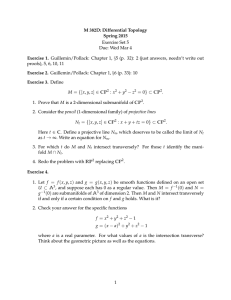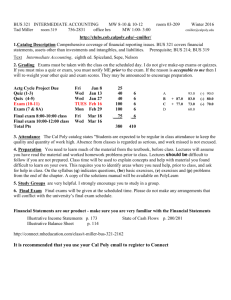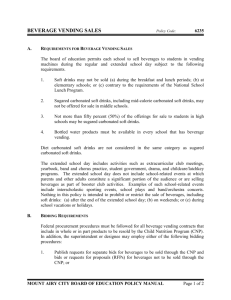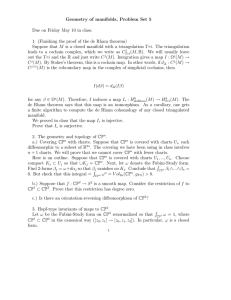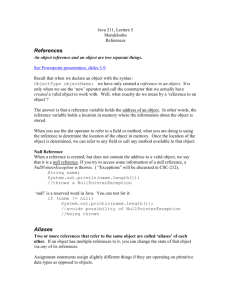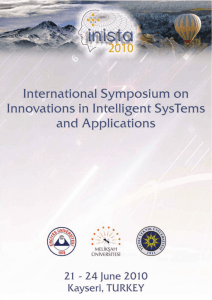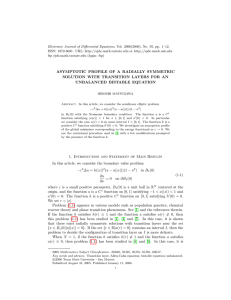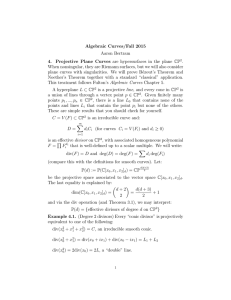elps5156-sup-0001-SupMat
advertisement
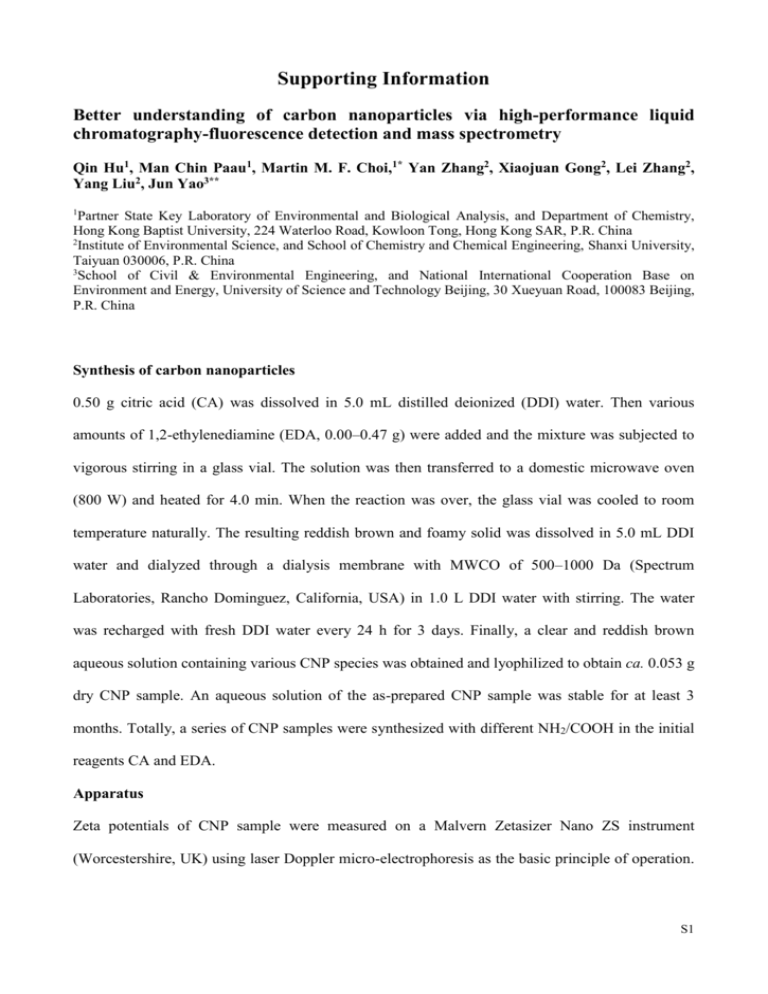
Supporting Information Better understanding of carbon nanoparticles via high-performance liquid chromatography-fluorescence detection and mass spectrometry Qin Hu1, Man Chin Paau1, Martin M. F. Choi,1* Yan Zhang2, Xiaojuan Gong2, Lei Zhang2, Yang Liu2, Jun Yao3** 1 Partner State Key Laboratory of Environmental and Biological Analysis, and Department of Chemistry, Hong Kong Baptist University, 224 Waterloo Road, Kowloon Tong, Hong Kong SAR, P.R. China 2 Institute of Environmental Science, and School of Chemistry and Chemical Engineering, Shanxi University, Taiyuan 030006, P.R. China 3 School of Civil & Environmental Engineering, and National International Cooperation Base on Environment and Energy, University of Science and Technology Beijing, 30 Xueyuan Road, 100083 Beijing, P.R. China Synthesis of carbon nanoparticles 0.50 g citric acid (CA) was dissolved in 5.0 mL distilled deionized (DDI) water. Then various amounts of 1,2-ethylenediamine (EDA, 0.00–0.47 g) were added and the mixture was subjected to vigorous stirring in a glass vial. The solution was then transferred to a domestic microwave oven (800 W) and heated for 4.0 min. When the reaction was over, the glass vial was cooled to room temperature naturally. The resulting reddish brown and foamy solid was dissolved in 5.0 mL DDI water and dialyzed through a dialysis membrane with MWCO of 500–1000 Da (Spectrum Laboratories, Rancho Dominguez, California, USA) in 1.0 L DDI water with stirring. The water was recharged with fresh DDI water every 24 h for 3 days. Finally, a clear and reddish brown aqueous solution containing various CNP species was obtained and lyophilized to obtain ca. 0.053 g dry CNP sample. An aqueous solution of the as-prepared CNP sample was stable for at least 3 months. Totally, a series of CNP samples were synthesized with different NH2/COOH in the initial reagents CA and EDA. Apparatus Zeta potentials of CNP sample were measured on a Malvern Zetasizer Nano ZS instrument (Worcestershire, UK) using laser Doppler micro-electrophoresis as the basic principle of operation. S1 The fundamental quantity measured is the net electrophoretic mobility (µ) of CNP which is converted to zeta potential (z) using the Smoluchowski formula [1,2]: µ= 2zε f(ka)/3η0 where ε is the dielectric constant (or permittivity), η0 refers to the viscosity of medium, and a is the particle radius. k is reciprocal length and 1/k = "thickness" of the electrical double layer (the Debye length). The term f(ka) refers to Henry’s function. This function takes the value of 1.5 for particles in polar medium (Smoluchowski approximation) and 1.0 for particles in nonpolar medium (Hückel approximation). Since aqueous media was used in our measurements, the Smoluchowski approximation was applied for calculation. The results were displayed as mean value of three replicate measurements with error bars indicating the standard deviations. The MALDI-TOF MS analyses of the isolated CNP fractions were performed on a Bruker Autoflex MALDI-TOF mass spectrometer (Bremen, Germany). The collected CNP fractions were dried by a stream of nitrogen gas, re-dissolved in 5.0 μL DDI and then mixed with a 1.0 M DHB solution in MeOH/water (1:1 v/v). 4.0 μL of this solution was deposited on a MALDI target plate. After being air-dried, the sample was inserted into the instrument and irradiated by a pulsed nitrogen laser at 337 nm. The positive ionization mode was applied to acquire the MS. The uv-visible absorption spectrum was recorded on a Varian Cary 100 Scan uv-visible absorption spectrophotometer (Palo Alto, California, USA) and the PL spectra were conducted on a Photon Technology International QM4 spectrofluorometer (Birmingham, NJ, USA). The TEM images were acquired on a JEOL JEM-2010 transmission electron microscope (Tokyo, Japan) at 200 kV. The FTIR spectra were performed on a Perkin-Elmer Paragon 1000 FTIR spectrometer (Waltham, MA, USA). References [1] Vanyorek, L., Meszaros, R., Barany, S., Colloids and Surfaces A: Physicochem. Eng. Aspects 2014, 448, 140-146. [2] Tantra, R., Schulze, P., Quincey, P., Particuology 2010, 8, 279-285. S2 Fig. S1. Effect of MeOH content on separation of CNP (1.0 mg/mL). The mobile phase contains 10 mM NH4Ac (pH 4.5) and various volume percentages of MeOH. All elutions are isocratic at 0.80 mL/min. Fluorescence chromatograms are monitored at excitation/emission wavelengths of 340/430 nm. Fig. S2. Effect of pH on separation of CNP sample (1.0 mg/mL). The mobile phases contain 10 mM NH4Ac at various pHs. All elutions are isocratic at 0.80 mL/min. Fluorescence chromatograms are monitored at excitation/emission wavelengths of 340/430 nm. S3 Fig. S3. Zeta potentials of CNP sample (0.50 mg/mL) at various pH. Each data is obtained from three measurements with the error bar. Fig. S4. Normalized uv-visible absorption (left) and photoluminescence spectra at different excitation wavelengths of 310–400 nm (right) of the CNP aqueous solution (1.0 mg/mL). The inset displays the TEM image of the as-prepared CNP. S4 Fig. S5. FTIR spectra of (1) carbon nanoparticles, (2) 1,2-ethylenediamine and (3) citric acid. S5 (1) (2) (3) (4) (5) (6) S6 (7) (8) (9) (10) Fig. S6. Photoluminescence spectra of HPLC fractions 1-10 at different excitation wavelengths. Table S1. Quantum yields (QY) of fractions 1–10 using quinine sulfate as the reference at excitation/emission wavelengths of 340/430 nm Fraction 1 2 3 4 5 6 7 8 9 10 QY (%) 1.31 1.04 10.03 6.81 4.71 4.54 0.64 1.23 14.98 15.83 S7 (A) (B) Fig. S7. Capillary electrophoretic separation of HPLC fractions 1–10 with run buffer of 30 mM NaAc at pH: (A) 4.5 and (B) 6.0. (0) Before each analysis, DMF was run as the neutral marker. Electropherograms are obtained at absorption wavelength of 250 nm and offset for clarity and ease of comparison. The later migration peak on each chromatogram of fractions 1–10 is acetate anion (Ac–) left in the collected fraction. S8 (1A) (1C) (2A) (2C) (1B) (1D) (2B) (2D) S9 (3A) (3B) (3C) (4A) (4B) (4C) (5A) (5B) S10 (5C) (6B) (7A) (7C) (6A) (6C) (7B) (7D) S11 (8A) (8C) (8B) (8D) (9A) (9B) (9C) (9D) S12 (10A) (10C) (10B) (10D) Fig. S8. (A) MALDI-TOF MS of HPLC fractions 1–10. (B–D) The expanded MS of each fraction. S13
